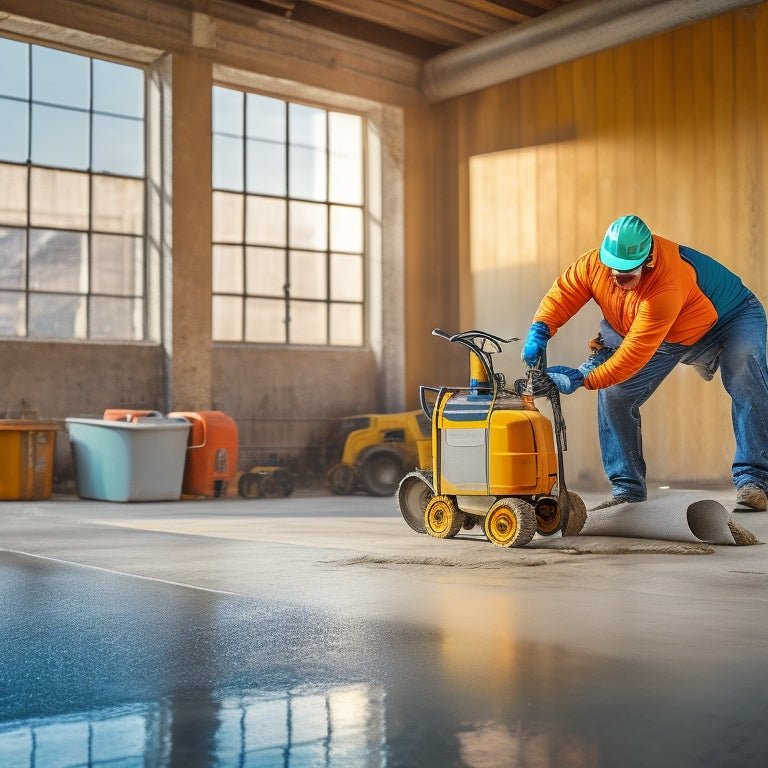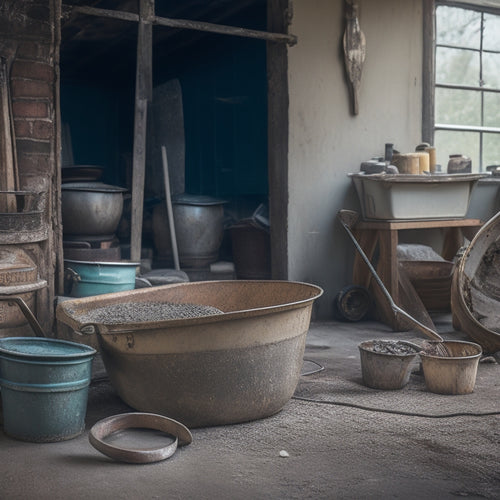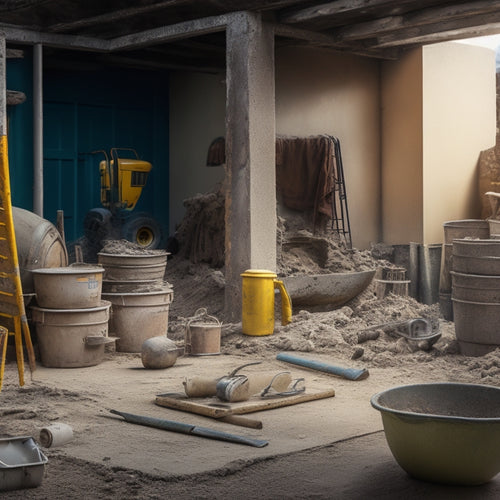
Top Tools for Concrete Sealing Success
Share
You require a well-stocked arsenal of specialized tools to achieve ideal results in concrete sealing, spanning surface preparation, sealer application, cleaning, safety gear, and additional accessories. From floor scrapers and wire brushes for surface prep to lambswool applicators and microfiber mops for sealer application, each tool plays a vital role in the process. Additionally, you'll need cleaning equipment, safety gear, and tool storage solutions to guarantee a successful project. By investing in the right tools and implementing proper maintenance and safety protocols, you'll be well on your way to a professionally finished concrete seal. Now, get ready to dive deeper into the specifics of each tool and how to maximize their potential.
Key Takeaways
- Essential tools for concrete sealing include surface preparation tools, sealer application tools, cleaning equipment, safety gear, and additional accessories.
- Tool maintenance and repair involve daily inspections, weekly deep cleaning, monthly overhauls, record keeping, and training and awareness.
- Safety precautions for operators include personal protective gear, proper ventilation, chemical handling, emergency preparedness, and workplace organization.
- Effective sealing tool storage solutions involve protecting sealant supplies, organizing tool stations, securing chemical containers, inventory management, and safety compliance.
- Investing in advanced sealing tool features, such as automated spray systems and data tracking capabilities, can enhance sealing accuracy, speed, and quality.
Essential Sealing Tool Checklist
You'll need a thorough set of tools to guarantee a successful concrete sealing project, and having the right equipment is essential to achieving professional-looking results.
The essential sealing tool checklist includes various sealing tool types, each designed for specific sealing application techniques.
For surface preparation, you'll need a floor scraper or a wire brush to remove dirt, oil, and old sealers. A broom or a blower is necessary for cleaning the surface.
A concrete grinder or a shot blaster may be required for more aggressive surface preparation.
For applying sealers, you'll need a variety of tools, including a lambswool applicator, a foam brush, or a microfiber mop. These tools are designed for specific sealing application techniques, such as applying a uniform coat or reaching tight spaces.
Additionally, you'll need a roller extension pole, a tray, and a pouring pot for efficient sealer application.
Lastly, you'll need safety equipment, including gloves, safety glasses, and a respirator, to protect yourself from the sealer and other hazardous materials.
With these essential tools, you'll be well-equipped to tackle any concrete sealing project and achieve professional-looking results.
Tool Maintenance and Repair
The longevity and effectiveness of your concrete sealing tools depend on regular maintenance and timely repairs. Neglecting these vital tasks can lead to premature wear, reduced performance, and even safety hazards.
By incorporating tool maintenance and repair into your workflow, you can extend tool longevity, reduce downtime, and guarantee consistent results.
To keep your tools in top condition, follow these maintenance schedules:
-
Daily inspections: Check for signs of wear, damage, or malfunction. Clean and lubricate moving parts as needed.
-
Weekly deep cleaning: Disassemble tools to remove dirt, debris, and old sealant residue. Reassemble and test tools to confirm proper function.
-
Monthly overhaul: Perform detailed inspections, replace worn or damaged parts, and recalibrate tools as necessary.
Safety Precautions for Operators
When you're working with concrete sealing tools, you'll need to prioritize your safety above all else.
You'll want to wear personal protective gear, including gloves, safety glasses, and a respirator, to prevent skin contact and inhalation of hazardous chemicals.
Additionally, you must guarantee proper ventilation methods are in place to minimize exposure to volatile organic compounds (VOCs) and other airborne contaminants.
Personal Protective Gear
Protecting yourself from potential hazards is vital during concrete sealing operations. You'll be working with chemicals, heavy equipment, and rough surfaces, so it's important to wear the right gear to prevent injuries and illnesses.
To guarantee your safety, you'll need:
-
Gloves: Choose from various glove types, such as nitrile, latex, or PVC, depending on the specific chemicals you're working with. Look for gloves with grip patterns to prevent slipping and dropping equipment.
-
Masks: Select from a range of mask options, including half-face or full-face respirators, to protect yourself from inhaling dust, fumes, and chemicals. Make sure the mask fits snugly and is properly sealed.
-
Safety glasses or goggles: These will shield your eyes from chemical splashes, flying debris, and other hazards. Opt for lenses with anti-fog coatings to maintain clear visibility.
Proper Ventilation Methods
Operating in a well-ventilated area is vital during concrete sealing operations, as it prevents the buildup of hazardous fumes and airborne contaminants that can cause serious health issues.
You must guarantee that your workspace has adequate ventilation to remove solvents, sealers, and other chemicals that can evaporate quickly.
When performing indoor sealing, it's important to open windows and doors to allow fresh air to circulate.
If you're working in a confined or enclosed space, consider using mechanical ventilation techniques, such as exhaust fans or ventilation systems, to remove contaminated air.
Additionally, avoid sealing concrete in areas with poor air circulation, like basements or crawl spaces, as this can lead to the accumulation of toxic fumes.
By implementing proper ventilation methods, you can greatly reduce the risks associated with concrete sealing operations and create a safer working environment.
Sealing Tool Storage Solutions
You'll need to protect your sealant supplies from contamination and degradation by storing them in a clean, dry environment, away from direct sunlight and moisture.
Organizing your tool stations with designated areas for each type of equipment will help you quickly locate what you need and prevent damage to your tools.
Protecting Sealant Supplies
Sealant supplies are a significant investment for any concrete sealing project, and their longevity depends on proper storage.
You need to guarantee that your sealant supplies remain in prime condition to achieve successful concrete sealing outcomes. Improper storage can lead to contamination, degradation, or even render your sealants unusable.
To protect your sealant supplies, follow these storage best practices:
-
Store in a cool, dry place: Avoid storing sealants in areas with high temperatures, humidity, or exposure to direct sunlight, as this can cause degradation or separation of the sealant components.
-
Keep containers tightly sealed: Confirm that all containers are tightly closed to prevent contamination and moisture ingress.
-
Label and organize containers: Properly label and organize your sealant containers to prevent mix-ups and guarantee easy access to the right sealant types and application techniques.
Organizing Tool Stations
As you set up your concrete sealing operation, having a well-organized tool station is essential for efficiency and productivity. A cluttered workspace can lead to wasted time, lost materials, and decreased quality of work.
Implementing effective tool organization strategies guarantees you have everything you need within reach, reducing downtime and increasing profitability.
Start by designating specific areas for each type of tool, such as a section for sealant application tools and another for surface preparation equipment. Use storage solutions like bins, baskets, and hooks to keep tools off the floor and organized.
Label each storage container to facilitate easy identification and retrieval. Consider a mobile tool cart or workstation to maximize space and allow for flexibility in your workflow.
A well-organized tool station also promotes a safer work environment. By keeping cords and hoses organized, you reduce tripping hazards and prevent damage to equipment.
With an efficient workspace setup, you can focus on delivering high-quality results and growing your business. By investing time in organizing your tool station, you'll reap the benefits of increased productivity and profitability in the long run.
Securing Chemical Containers
Chemical containers, a critical component of any concrete sealing operation, require careful storage and handling to guarantee safety, efficiency, and compliance.
You'll need to take into account the types of chemical containers you use, such as drums, totes, or pails, and make sure they're stored in a way that prevents leakage, contamination, or damage.
When it comes to container storage, you should:
- Designate a specific area for chemical storage, away from heat sources, open flames, and ignition sources.
- Use secondary containment measures, such as spill pallets or berms, to capture any accidental releases.
- Label and organize containers by type, date, and contents to facilitate easy identification and access.
Budgeting for Cinder Block Tools
Your cinder block project's success hinges on having the right tools for the job, and that means budgeting accordingly. Cinder block costs can add up quickly, and tool investment is a vital aspect to contemplate.
You'll need to allocate funds for essential tools like a high-pressure washer, a concrete sealer applicator, and a scrub brush. These tools will help you prepare the surface, apply the sealer, and clean up efficiently.
When creating your budget, factor in the size of your project and the type of cinder block you're working with. Larger projects will require more materials and equipment, increasing your overall costs.
Additionally, take into account the quality of the tools you're purchasing. While cheaper options may seem appealing, they may not provide the same level of performance and durability as higher-end tools.
A well-planned budget will guarantee you have the necessary tools to complete your project successfully. By investing in the right equipment, you'll save time, reduce labor costs, and achieve a professional-looking finish.
Don't skimp on tool investment – it's a vital step in achieving a successful cinder block project.
Advanced Sealing Tool Features
While preparing your cinder block surface for sealing, you'll want to contemplate investing in advanced sealing tool features that can elevate the efficiency and quality of your project.
These features can make a significant difference in the final outcome, saving you time and effort in the long run.
When selecting advanced sealing tool features, consider the following:
-
Advanced Technology: Look for tools that incorporate advanced technology, such as automated spray systems or precision applicators. These features can improve the accuracy and speed of your sealing process.
-
User-Friendly Design: Opt for tools with user-friendly designs that reduce operator fatigue and improve overall productivity. Ergonomic handles, adjustable nozzles, and intuitive controls can make a significant difference in your work experience.
-
Data Tracking and Analytics: Consider tools that offer data tracking and analytics capabilities, enabling you to monitor and optimize your sealing process. This feature can help you identify areas for improvement and refine your techniques over time.
Frequently Asked Questions
Can I Use Concrete Sealing Tools on Newly Poured Concrete?
You shouldn't apply sealing tools to new concrete immediately, as it can trap moisture and hinder curing. Instead, wait 28 days for full curing, then assess the surface and apply sealing techniques suitable for the new concrete's porosity and finish.
How Often Should I Reapply Concrete Sealer to Maintain Protection?
You'll need to reapply concrete sealer every 1-3 years, depending on sealer longevity and environmental factors, to maintain a consistent maintenance schedule that guarantees ideal protection and prevents damage from weathering and wear.
Are Concrete Sealing Tools Suitable for Indoor and Outdoor Use?
Renaissance masters would envy your attention to detail! You'll be pleased to know that most concrete sealing tools are designed for both indoor applications, where subtlety reigns, and outdoor durability, where harsh elements demand resilience.
Can I Use Concrete Sealing Tools on Stained or Painted Concrete?
When working with stained concrete or painted surfaces, you'll need to choose sealing tools specifically designed for these applications, as they require gentle, even application to avoid damaging the finish or compromising adhesion.
Do I Need Special Training to Operate Concrete Sealing Tools?
When operating concrete sealing tools, you'll want to guarantee you're properly trained to follow safety precautions and perform regular tool maintenance to prevent accidents and extend equipment lifespan, especially when working with chemicals and heavy machinery.
Conclusion
As you stand victorious on a job well done, your arsenal of high-quality concrete sealing tools glistening in the sunlight, you can't help but feel a sense of pride and accomplishment. Your precision-crafted tools have been your trusted allies, helping you conquer even the most intimidating concrete sealing challenges. With the right tools by your side, the possibilities are endless, and your future projects will shine like polished concrete.
Related Posts
-

Top Tools for Mixing Concrete at Home
When mixing concrete at home, you'll need a range of tools to guarantee a successful operation. Start with essential ...
-

Concrete Foundation Building Tools for Homeowners' Success
As you start your concrete foundation building project, it is vital to have the right tools to guarantee success. You...
-

What Tools Are Needed for Concrete Wall Foundations
You'll need a thorough array of tools and equipment to construct a concrete wall foundation that meets structural int...


